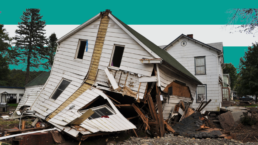By Evlondo Cooper, Prism
[Cooper analyzes television coverage of Hurricane Ida and uncovers a simple fact: broadcasters are deliberately hiding information about an underlying cause (climate change) and an obvious result (poor Black and brown people are the most vulnerable). It matters that we hold the press accountable for reporting that so clearly manages to keep some of the most important facts out of public consciousness. — Progressive Hub]
Coverage of Hurricane Ida’s landfall followed this too-familiar pattern: not only did most of the national TV news’ reporting fail to connect the storm to climate change, but the coverage also didn’t tell viewers how and why vulnerable communities suffer more from climate-fueled extreme weather events. I know this because I research it for a living. A recent Media Matters analysis found that from Aug. 27-30—when Ida quickly grew to a Category 4 hurricane—just 4% of the combined 774 total national TV news segments on Hurricane Ida mentioned climate change. To simplify, 96% of coverage ignored the key reason why hurricanes like Ida are much more dangerous.
The storm’s rapid intensification harmed evacuation efforts, especially for people who lacked the means or money to temporarily relocate out of Ida’s path. This is just one of many ways that climate-fueled extreme weather events like hurricanes disproportionately affect marginalized communities and people of color. But if you don’t understand why the same communities are ill-equipped to evade and recover from increasingly frequent and devastating storms like Hurricane Ida year after year, you’d be hard-pressed to find the answers during national TV news’ coverage of Ida’s path through southern Louisiana.
Recent Posts
‘Unconstitutional. Unethical. Authoritarian.’ ICE Bars Millions Of Immigrants From Bond Hearings
July 18, 2025
Take Action Now One watchdog said the new policy “seems like a blatant attempt to stop them from exercising their right to due process.”……
Americans Are Not Nearly Alarmed Enough About Climate Change
July 18, 2025
Take Action Now Americans still don’t comprehend how imminent, dangerous, and far-reaching the threat is—and journalists are partly to blame.By…
The IRS Is Building A Vast System To Share Millions Of Taxpayers’ Data With ICE
July 17, 2025
Take Action Now ProPublica has obtained the blueprint for the Trump administration’s unprecedented plan to turn over IRS records to Homeland Security…
Israel’s Sudden Assault On Syria Is Unchecked Aggression
July 17, 2025
Take Action Now Jerusalem is bombing Damascus and threatening al-Sharaa’s rule, while Washington was hoping to help the nascent government on…





